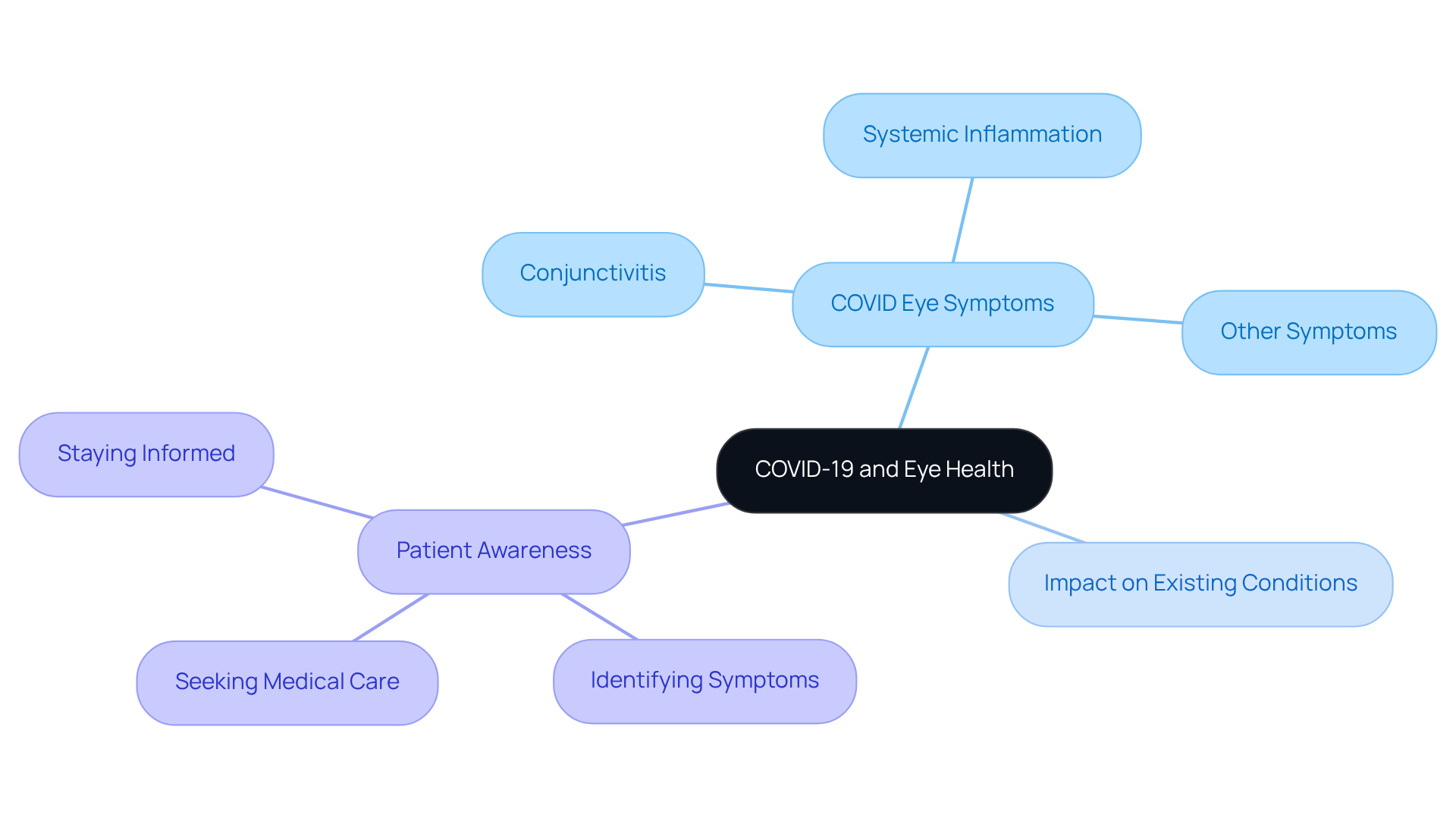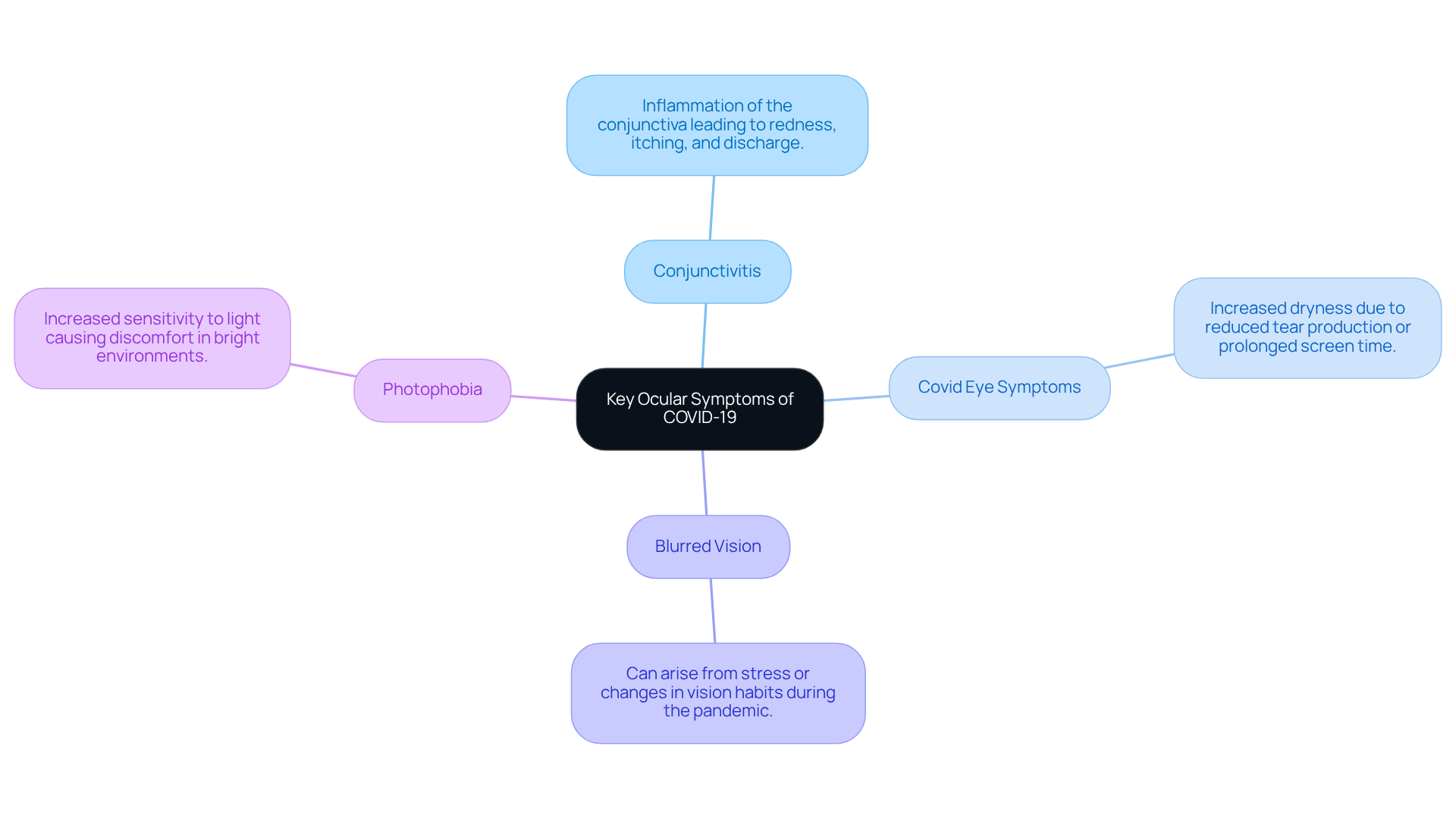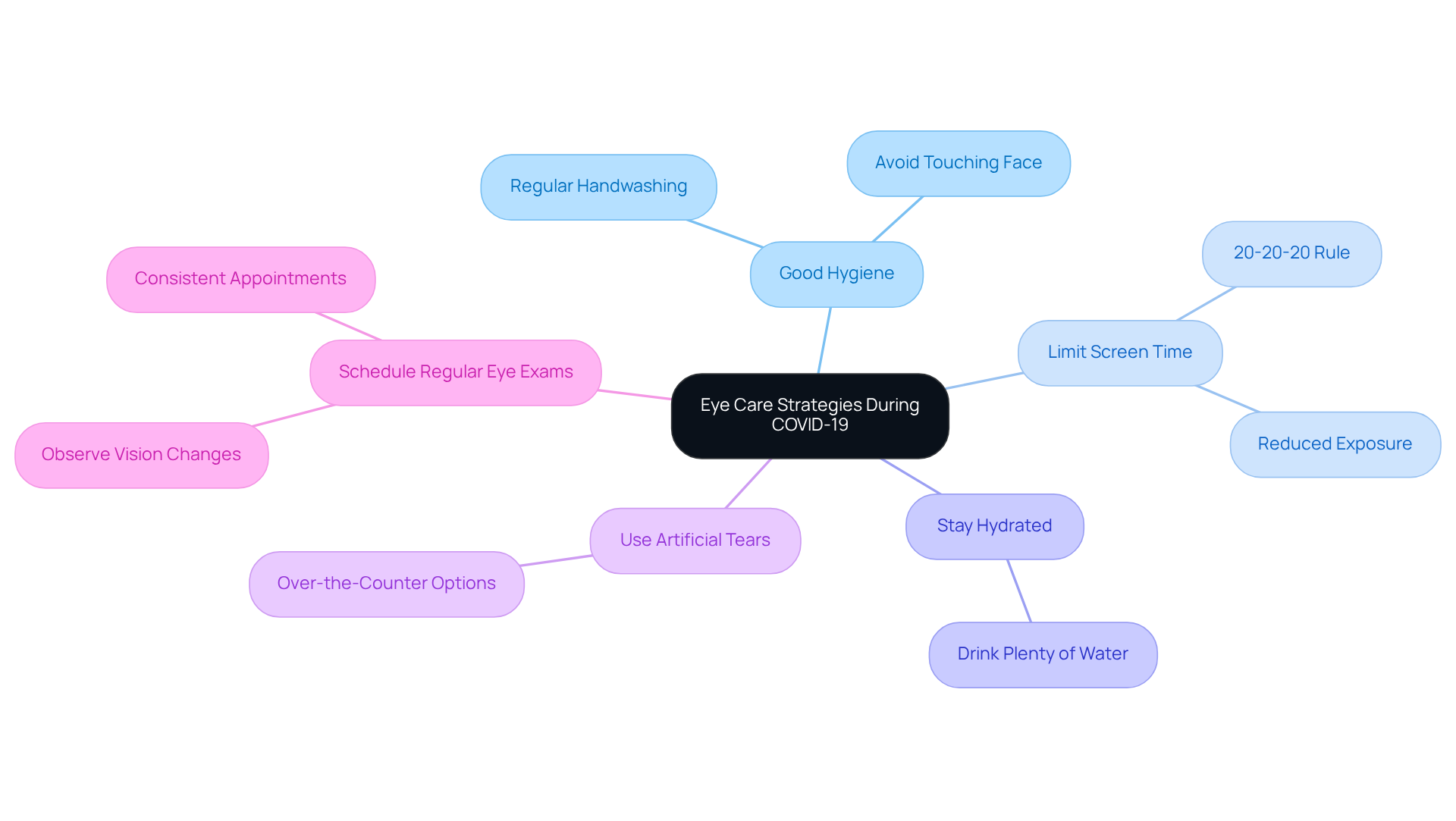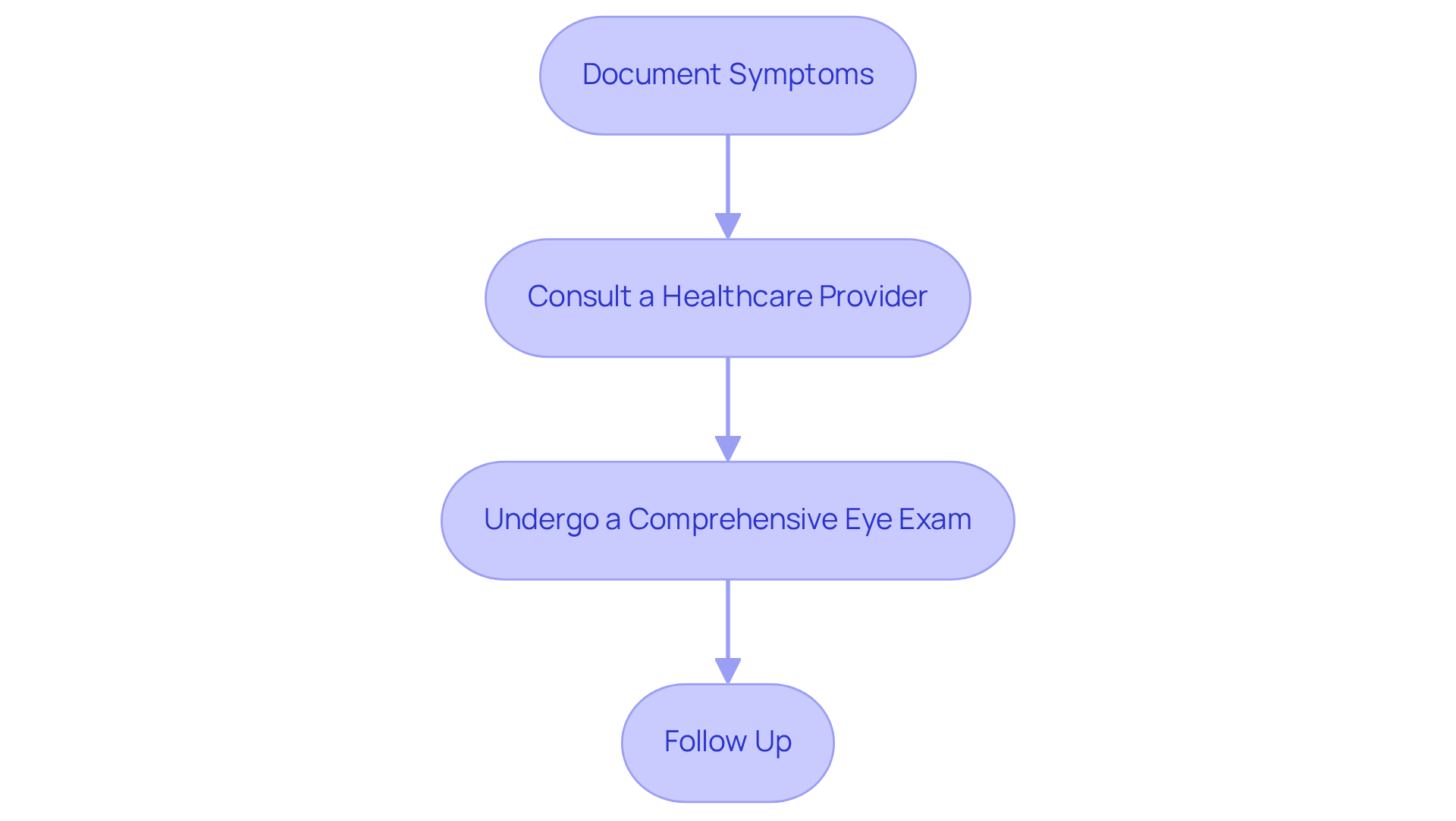Posted by: Northwest Eye in General on October 12, 2025
Overview
This article focuses on understanding the eye symptoms associated with COVID-19 and essential care strategies for patients. We understand that experiencing these symptoms can be concerning. COVID-19 can lead to ocular issues such as conjunctivitis, dryness, and blurred vision. It’s common to feel anxious about these changes in your vision.
To help manage these symptoms effectively, it’s important to adopt proactive eye care practices. Simple steps like:
- Maintaining good hygiene
- Limiting screen time
- Scheduling regular eye exams
can make a significant difference. We encourage you to take these actions to protect your eye health and alleviate your concerns.
Remember, you are not alone in this journey. Many individuals are navigating similar challenges, and support is available. We are here to help you through this process and ensure that you feel reassured and cared for.
Introduction
COVID-19 has reshaped our understanding of health, revealing unexpected connections between respiratory illness and eye health. We understand that this can be concerning, especially as research uncovers the ways the virus can impact ocular conditions.
Patients are now faced with the challenge of recognizing and managing COVID-related eye symptoms like conjunctivitis and dryness.
How can you effectively navigate these emerging concerns and protect your vision in the midst of a pandemic? This article delves into essential care strategies that empower you to identify symptoms early and take proactive steps to safeguard your eye health.
Explore the Connection Between COVID-19 and Eye Health
COVID-19 is primarily a respiratory illness, but we understand that it can also raise concerns about covid eye symptoms and their impact on eye health. Research has shown that the virus can enter the body through the conjunctiva, the thin membrane covering the eye, leading to various eye issues, including covid eye symptoms like conjunctivitis, commonly known as ‘pink eye.’ While conjunctivitis may not be as prevalent as fever, cough, and difficulty breathing, it is important for our scheduling team to take this into account.
Additionally, systemic inflammation caused by the virus can exacerbate existing eye conditions or lead to new ones. Grasping this connection is crucial for you as a patient, as it can help you identify when to seek medical care for eye-related issues, particularly covid eye symptoms, that may arise during or after a coronavirus infection. We encourage you to keep abreast of the latest research findings, as this knowledge can empower you to take proactive steps in managing your eye health during the pandemic.

Identify Key Ocular Symptoms of COVID-19
Key ocular symptoms associated with COVID-19 include:
- Conjunctivitis (Pink Eye): We understand that inflammation of the conjunctiva can occur, leading to redness, itching, and discharge, which can be quite uncomfortable.
- Covid eye symptoms: During isolation, it’s common to experience increased dryness due to reduced tear production or prolonged screen time. We want you to know that you are not alone in this.
- Blurred Vision: This symptom can arise from various factors, including stress or changes in vision habits during the pandemic, and is one of the covid eye symptoms. It’s important to acknowledge how these changes can impact your daily life.
- Photophobia: Sensitivity to light may increase, which is one of the covid eye symptoms, causing discomfort in bright environments. We recognize that this can be particularly challenging.
Identifying covid eye symptoms early can encourage you to pursue suitable treatment, especially if you have been exposed to the virus. Remember, we are here to help you through this process.

Implement Strategies for Eye Care During COVID-19
To maintain optimal eye health during the COVID-19 pandemic, we understand that many are concerned about covid eye symptoms and their vision. Consider these supportive strategies:
- Practice Good Hygiene: Regular handwashing is crucial. We encourage you to refrain from touching your face, especially around your eyes, to reduce the risk of infection. As Ailsa Lane emphasizes, “Eyecare practitioners and parents need to be aware of visual problems associated with prolonged digital device use.”
- Limit Screen Time: With increased digital device usage, which surged by 3-5 hours daily during the pandemic, it’s common to feel overwhelmed. It’s essential to reduce screen exposure. Implement the 20-20-20 rule: every 20 minutes, look at something 20 feet away for 20 seconds to alleviate digital eye strain. Reports indicate that digital eye strain (DES) symptoms affected up to 74% of individuals during this period.
- Stay Hydrated: Adequate hydration supports tear production, helping to prevent dry eyes. We recommend aiming to drink plenty of water throughout the day.
- Use Artificial Tears: Over-the-counter artificial tears can effectively relieve dryness and discomfort, especially for those experiencing increased screen time.
- Schedule Regular Eye Exams: Keeping consistent eye care appointments is crucial, even during the pandemic. We encourage you to observe any changes in your vision or general eye condition. Regular check-ups can help identify issues early, ensuring timely intervention.
These practices not only enhance eye well-being but also address the increasing occurrence of digital eye strain and covid eye symptoms, which have been reported to affect up to 74% of individuals during the pandemic. By adopting these strategies, you can better protect your vision and overall eye health. Remember, we are here to help you through this process.

Diagnose COVID-Related Eye Symptoms Effectively
To effectively diagnose COVID-related eye symptoms, we understand how important it is for you to take the following steps:
- Document Symptoms: Keep a detailed record of any ocular symptoms you experience, noting their onset, duration, and severity. This documentation is essential for your healthcare provider to understand how your symptoms have developed and to customize suitable interventions.
- Consult a Healthcare Provider: Reach out to an ophthalmologist or your primary care physician to discuss your symptoms and any recent exposure to the virus. Early consultation can facilitate timely diagnosis and management, helping you feel more secure in your health journey.
- Undergo a Comprehensive Eye Exam: Prepare for a thorough examination, which may include visual acuity tests, a slit-lamp examination, and possibly imaging studies to evaluate the condition of your eyes. These evaluations are crucial for detecting any eye issues, including covid eye symptoms, that may develop due to the virus, providing you with peace of mind.
- Follow Up: After diagnosis, adhere to any recommended treatment plans and schedule follow-up appointments with your healthcare provider to monitor your recovery and address any ongoing concerns.
Recording visual indications is not only crucial for your individual health management but also enhances overall understanding and studies on covid eye symptoms and the virus’s effect on eye health. For instance, patients who reported symptoms such as conjunctivitis or blurred vision received timely interventions, significantly improving their outcomes. As one ophthalmologist noted, “Understanding the ocular manifestations of COVID-19 is critical for effective patient care and timely referrals.” This proactive approach can lead to better health outcomes and enhance overall eye health during these challenging times. Remember, we are here to help you through this process.

Conclusion
Understanding the intricate relationship between COVID-19 and eye health is vital for patients navigating the complexities of this pandemic. We understand that while COVID-19 is primarily a respiratory illness, it can also manifest through various ocular symptoms, such as conjunctivitis and blurred vision. Recognizing these symptoms early can empower individuals to seek timely medical care, ultimately protecting their vision and overall eye health.
Throughout this discussion, we highlight the importance of identifying specific ocular symptoms associated with COVID-19. It’s essential to implement effective eye care strategies and ensure accurate diagnosis. Practicing good hygiene, limiting screen time, and scheduling regular eye exams are proactive measures that can significantly mitigate the risk of eye-related complications during these challenging times.
In light of the ongoing challenges posed by COVID-19, prioritizing eye health is crucial. We encourage you to remain vigilant about any changes in your vision. By adopting recommended care strategies and maintaining open communication with your healthcare providers, you can safeguard your ocular well-being. Remember, staying informed and proactive can lead to better health outcomes, reinforcing the critical importance of eye care amid this ongoing health crisis.
Frequently Asked Questions
What is the primary illness caused by COVID-19?
COVID-19 is primarily a respiratory illness.
Can COVID-19 affect eye health?
Yes, COVID-19 can raise concerns about eye health and may lead to various eye issues, including symptoms like conjunctivitis.
What are covid eye symptoms?
Covid eye symptoms include conjunctivitis, commonly known as ‘pink eye.’
How does the virus enter the body through the eyes?
The virus can enter the body through the conjunctiva, the thin membrane covering the eye.
Is conjunctivitis a common symptom of COVID-19?
While conjunctivitis may occur, it is not as prevalent as other symptoms such as fever, cough, and difficulty breathing.
How does COVID-19 affect existing eye conditions?
Systemic inflammation caused by the virus can exacerbate existing eye conditions or lead to new ones.
Why is it important for patients to understand the connection between COVID-19 and eye health?
Understanding this connection can help patients identify when to seek medical care for eye-related issues that may arise during or after a coronavirus infection.
What should patients do to manage their eye health during the pandemic?
Patients are encouraged to keep abreast of the latest research findings to empower themselves in managing their eye health.






